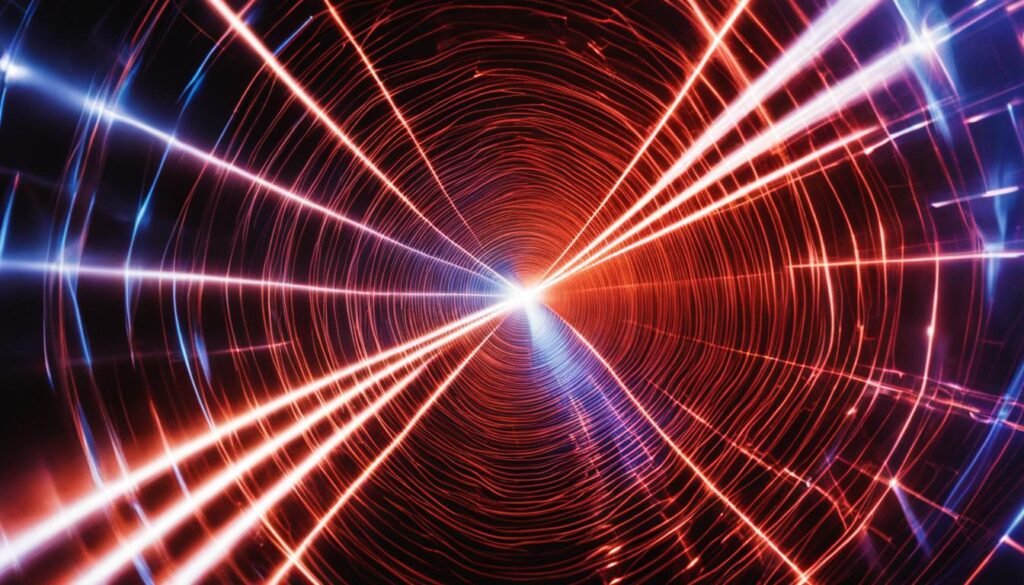Contents [hide]
Laser pulse energy calculation is an important aspect in various industries. The calculation process involves determining the amount of energy contained in laser pulses, whether it is in individual pulses or for a known and finite amount of time. For a pulsed laser, the average power of the source is divided by the repetition rate to calculate the pulse energy. On the other hand, for a CW or pulsed laser fired for a known duration, the average power is multiplied by the pulse duration to determine the pulse energy. Laser power meters and energy meters are commonly used instruments to measure the average power and repetition rate or pulse duration, respectively. Having an accurate measurement of pulse energy is crucial in applications such as medical treatments, where the energy needs to be stable for both safety and efficiency purposes.
Key Takeaways:
- Laser pulse energy calculation is essential in various industries.
- The calculation process depends on whether the laser is pulsed or continuous.
- For pulsed lasers, divide the average power by the repetition rate to calculate pulse energy.
- For CW or pulsed lasers, multiply the average power by the pulse duration to determine pulse energy.
- Laser power meters and energy meters are commonly used instruments for accurate measurements.
Calculating Laser Pulse Energy for Pulsed Lasers
When it comes to calculating the pulse energy for a pulsed laser, the process is relatively straightforward. The average power of the laser source is divided by its repetition rate. Laser power meters are commonly used to measure the average power, while energy meters are used to measure both the energy per pulse and the repetition rate.
The pulse energy calculation equation is simply:
Pulse energy (J) = Average power (W) / Repetition rate (Hz)
For example, let’s consider a laser with an average power of 200 W and a repetition rate of 20 Hz. By dividing the average power by the repetition rate, we can determine that each pulse of the laser has an energy of 10 J.
It’s important to note that while laser specification sheets may provide the average power and repetition rate, direct measurements using suitable instruments are recommended for better accuracy. Utilizing a laser power meter and an energy meter ensures precise calculations of pulse energy, which is crucial for various applications in industries such as healthcare, manufacturing, and research.
| Average Power (W) | Repetition Rate (Hz) | Pulse Energy (J) |
|---|---|---|
| 200 | 20 | 10 |
By accurately calculating the pulse energy of pulsed lasers, professionals can ensure the proper functioning and performance of laser systems. Understanding the basic calculation method and using suitable instruments for measurements are key to achieving reliable and consistent results.
Calculating Laser Pulse Energy for CW or Pulsed Lasers
When determining the pulse energy of a continuous wave (CW) or pulsed laser fired for a known duration, it is essential to consider both the average power and the pulse duration. These two parameters play a crucial role in calculating the energy output of the laser system.
The average power of a laser source is a measure of the laser’s output over a given period. It can be obtained through direct measurement using laser power meters. The pulse duration, on the other hand, refers to the length of time the laser pulse is emitted during each firing cycle. This parameter can be provided on laser specification sheets or directly measured using suitable instruments.
To calculate the pulse energy for a CW or pulsed laser, the average power is multiplied by the pulse duration. The resulting value represents the total energy directed towards the target during the laser firing. The equation for pulse energy calculation is as follows:
Pulse energy (J) = Average power (W) * Pulse duration (s)
For example, let’s consider a CW laser with an average power of 500 W and a pulse duration of 5 seconds. Applying the pulse energy calculation equation, we find that the total energy directed towards the object would be 2500 J. Similarly, if the same laser has a pre-programmed pulse duration of 200 ms, the total energy output would be 100 J. By modulating the pulse width or duration, it becomes possible to control the laser’s total energy output.
Having an accurate calculation of pulse energy is crucial in various applications. In medical treatments, for instance, it ensures the laser energy is stable and delivers the desired effect for both safety and efficacy. Regular measurements and adjustments are recommended to account for any variations in laser performance over time and maintain consistent results.
| Average Power (W) | Pulse Duration (s) | Pulse Energy (J) |
|---|---|---|
| 500 | 5 | 2500 |
| 500 | 0.2 | 100 |
Table: Examples of pulse energy calculations for a CW laser with different average powers and pulse durations.
Conclusion
Laser pulse energy calculation is a crucial aspect in a wide range of industries. By accurately measuring and calculating the pulse energy, professionals can ensure the safe and efficient operation of laser systems. This is especially important in medical applications, where precise energy control is necessary for both patient safety and treatment efficacy.
Laser power meters and energy meters are commonly used instruments to measure average power, repetition rate, and pulse duration. These measurements enable professionals to calculate the pulse energy with precision. Regular measurements and adjustments are recommended to account for any variability in laser performance over time.
By understanding the essentials of laser pulse energy calculation, professionals can make informed decisions and optimize the performance of their laser systems. Laser pulse energy calculation techniques and accurate energy measurement are essential for maintaining consistent performance and avoiding both over- and under-treatment. By following these principles, professionals can ensure the safe and effective use of lasers in various applications.



